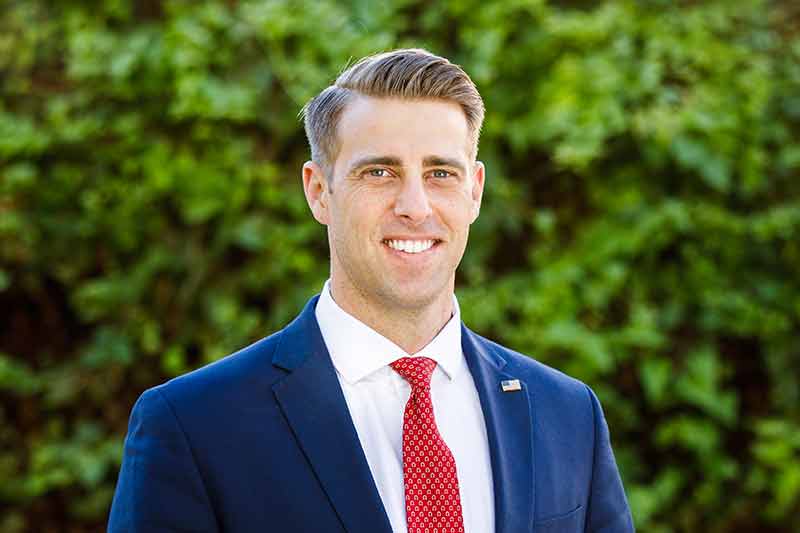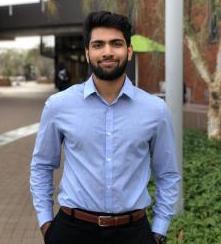Students solve real problems in real time with Hacking for Defense course
The project-driven course teaches problem-solving, creative thinking and solution development at lightning speed

Scrambling jets. Sweepings for mines. Clearing airfields. Designing hangars for multibillion-dollar planes. Developing a peer mentor program to improve mental health.
These are just a few of the problems that Arizona State University students solved last semester in an innovative and exciting setting.
The class, Hacking for Defense (H4D), searches for problem-solvers across all disciplines to address the nation’s emerging threats and security challenges.
Drew Trojanowski
“Everyone is looking for a really cool capstone-like project and this is it,” said Drew Trojanowski, assistant vice president of strategic initiatives with ASU Knowledge Enterprise. “We’re fortunate that ASU can offer this applied research activity to students.”
H4D is a program of the National Security Innovation Network and teaches students to work with the Department of Defense and intelligence community to rapidly address the nation’s emerging threats and security challenges with specific, mission-critical solutions.
But don’t let the term fool you. National security is a broad term that refers to efforts that ensure the country survives and thrives. It encompasses much more than people may realize, such as communications, design, psychology, health, agriculture, energy, business, analytics, artificial intelligence and engineering.
H4D is not specifically geared for computer science majors, tech-savvy individuals or those looking for a military career. The course draws on students from STEM, business, sustainability, entrepreneurship and design. This project also does not require an application at this time, so anyone can register.
For universities, it keeps their programs attached to real-world problems and provides students with an experiential opportunity to become more effective in their chosen field, with a body of work to back it up. It not only gives students applied experience in their fields, but also benefits local defense-related startups and companies, who will have a pool of knowledgeable future employees in a high-demand industry.
“The goal of the course is to demystify the military and break down some of the barriers between the Department of Defense and academia while offering students and researchers the ability of serving their country in a different form,” said Samantha Hiller, university program director for the National Security Innovation Network, a DoD program office within the office of secretary of defense, research and engineering. The network works with graduate, undergraduate and nontraditional problem-solvers to generate and accelerate new solutions to national security problems.
Hiller said university students bring a fresh perspective to problem-solving, critical thinking and solution development — and encourages students to take note that almost every technology vertical applies to the DoD.
Samantha Hiller
“Students are able to look at STEM-related issues objectively, which allows them to get to the heart of the matter,” Hiller said. “Secondly, they offer up 21st-century solutions that make lives easier and better for our military.”
A menu of problems are sourced directly from entities like the U.S. Army, U.S. Special Operations Command, the U.S. Navy, U.S. Air Force, U.S. Marine Corps and NASA. Students in the course will be working closely with DoD personnel, military members and representatives from each of these groups as well as other experts and class mentors.
Students break into teams of three to four, and each team receives a real-life problem statement from the military. That could range from helping Luke Air Force Base design new hangars for F-35s to developing a new software system for locating mines and gauging nitrogen levels to improving on a pre-flight checklist app for pilots so they can get into the air more efficiently.
Over the course of the semester, students work hand-in-hand with their problem sponsor as they interview people related to the field. Students continually develop their solution as they become experts on their topic. Students also design, build and test solutions for real-time DoD needs while engaging with both the military and civilian defense companies. The DoD needs aren’t all about weaponry and warcraft — most involve everyday problems that, if solved, would help service members be safer and more efficient.
Adam French
ASU students Adam French and Ryyan Mukarram were asked to help the Air Force develop a peer mentor program to reduce suicide and improve the mental health of service members. That included interviewing Air Force service members, chaplains, psychologists, counselors and outside organizations over a semester to learn how to recognize signs of depression.
They both said it was a rewarding 15-week experience.
“What impressed me most was that it was practical, hands-on and we had the opportunity to make our ideas come to life,” said Rich, an innovation and society major. “The connections I made, skills I learned, and fun I had blew my other classes out of the water.”
For Mukarram, the course was a way to network, open himself up to more opportunities and expand his skill set.
“HD4 made me become a better leader and learn how to approach interviews. Learning how to properly navigate an interview and test your hypothesis using A/B testing and validate the theory is crucial,” said Mukarram, a business data analytics graduate of the W. P. Carey School of Business. “Also learning how many people you need to reach out to when trying to contact people because only a handful will get back to you.”
Ryyan Mukarram
The upcoming fall 2020 semester of H4D will take place in ASU’s Innovation Space; however, ASU isn’t the only university participating in this program. H4D will open the students’ horizon to a nationwide network and it runs at several universities across the country, and the hundreds of DoD problems sources are from all over. This course will afford ASU students the opportunity to connect with military men and women as well as students in other states.
Hiller said students’ work and solutions have real-world impact, and NSIN incorporates their findings by striving for “solution adoption” by the DoD sponsor.
“Once the class is over, there is a real desire and effort to see how we can push these solutions as adoptions,” Hiller said. “The military community is excited about this opportunity because we are helping them work through challenges they may otherwise never have had the time or bandwidth to solve.”
Top photo courtesy of iStock/Getty Images.
More Science and technology

ASU receives 3 awards for research critical to national security
Three researchers in the Ira A. Fulton Schools of Engineering at Arizona State University have received grant awards under the Defense Established Program to Stimulate Competitive Research, or…

Celebrating 34 years of space discovery with NASA
This year, NASA's Hubble Space Telescope (HST) is celebrating its 34th anniversary of the world's first space-based optical telescope, which paved the scientific pathway for NASA's James Webb Space…

Making magic happen: Engineering and designing theme parks
The themed entertainment industry is widespread and diverse, encompassing everything from theme parks to aquariums, zoos, water parks, museums and more. The Theme Park Engineering and Design…



